
Paul Lavalle (born Joseph Usifer, [1] September 6, 1908 - June 24, 1997) was an American conductor, composer, arranger and performer on clarinet and saxophone.

Paul Lavalle (born Joseph Usifer, [1] September 6, 1908 - June 24, 1997) was an American conductor, composer, arranger and performer on clarinet and saxophone.
Lavalle was born in Beacon, New York, [2] the son of Ralph and Jennie Usifer, both Italian immigrants. Graduating from Beacon High School, he planned to study law at Columbia University. After winning a scholarship there,[ citation needed ] Lavalle studied music at the Juilliard School [2] and was a student of composition of Joseph Schillinger. He performed in many 1930s bands, including one in Havana, Cuba. In 1933 he became an arranger and clarinetist in the NBC house orchestra. His composition Symphonic Rhumba (1939), was broadcast by the NBC Symphony Orchestra, conducted by Leopold Stokowski, on December 6, 1942.
Lavalle worked on radio programs, including The Dinah Shore Show (1939–40), [3] : 100 The Chamber Music Society of Lower Basin Street (1940–44), [3] Plays for Americans (1942), Highways in Melody, [3] : 150 The Stradivari Orchestra (1943), [3] : 318 Strictly Business (1940), [3] : 320 The Ted Steele Show (1942), [3] : 327 and Dough Re Mi (1942-1943). [3] : 103 On his radio shows he collaborated with Victor Borge, Mario Lanza, Robert Merrill and Dinah Shore. In November 1944, his jazz composition "Always" made it to number 29 on the top 40 charts. In 1940, The New York Times described him as "NBC's ubiquitous music maker" and said he was "of small size, dynamic, dark haired..." Lavalle told the reporter, "Music is my life, and I am happy that it is so."[ citation needed ]
Lavalle was selected over several applicants to become the conductor of the Band of America in 1948. They performed on the weekly radio program Cities Service Concerts on NBC Radio [3] : 77 for eight years and almost 400 programs. Each program began with the introduction: "Forty-eight states... 48 stars... 48 men marching down the main street of everybody's hometown! Here comes the Cities Service Band of America, conducted by Paul Lavalle!"[ citation needed ]
In 1949, Lavalle and the band became one of the first musical groups to appear weekly on television.
On May 18, 1961, Paul Lavalle and the Greatest Band in America joined singer Kay Armen in a 30-minute episode of the ABC-TV series "Music For a Spring Night" entitled "Concert in the Park." The Band opened with a spirited medley ("76 Trombones," "Strike Up the Band,") and then Miss Armen took over with "I'll Be Seeing You" and other songs. [4] Beginning in 1964, the Band of America toured extensively and also became the official band of the 1964 New York World's Fair, an engagement that lasted into 1965.
Lavalle guest conducted many orchestras, including the ABC Symphony, CBS Symphony, NBC Symphony Orchestra, New York Philharmonic and Rochester Philharmonic Orchestra. In 1966 he became the conductor for the Radio City Music Hall Symphony Orchestra, and he returned two years later to serve as director of music and as principal conductor until 1975. In 1981 he began conducting the Wilton, Connecticut, Chamber Orchestra. In 1967, he was instrumental in forming the 100-member All-American High School Band (by 1968 known as McDonald's All-American High School Band) which participated in the Macy's Thanksgiving Day Parade and Tournament of Roses Parade.
Paul Lavalle used his birth name, Joseph Usifer, for performances until at least 1938, and he then used the name Paul Laval in the 1940s. In 1938, a rare Brunswick Records 78rpm recording was issued under Joe Usifer's name, an extremely sophisticated and intricate swing arrangement, in the tradition of Raymond Scott, of "In The Hall of the Mountain King" b/w "The Jockey On The Carousel". Recorded by Irving Mills, it was one of the first records issued on Brunswick after the collapse of Mills' Master Records label (remaining top selling Master records were moved to Brunswick).
Paul Lavalle was married twice. He met Sarah "Sally" Grant (22 July 1904 - 18 January 1992), a native of North Sydney, Nova Scotia, Canada, while in Cuba, and they were married in New York. They had one son, Lawrence Usifer (5 October 1941 - 11 December 2002). The marriage ended in divorce in 1946. Muriel Angelus met Lavalle while she was performing on the radio, and they married in 1946. She retired from acting to raise a family. They maintained an apartment in Manhattan and a Colonial home in Connecticut. Their daughter, Suzanne Lavalle Bothamley, was an NBC reporter and became a realtor in Virginia. Paul Lavalle died June 24, 1997, in Harrisonburg, Virginia at the Rockingham Memorial Hospital.[ citation needed ]
Lavalle made many recordings, mostly on RCA.
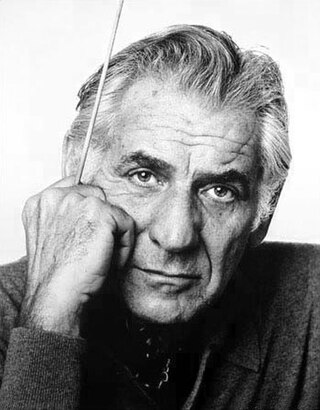
Leonard Bernstein was an American conductor, composer, pianist, music educator, author, and humanitarian. Considered to be one of the most important conductors of his time, he was the first American conductor to receive international acclaim. Bernstein was "one of the most prodigiously talented and successful musicians in American history" according to music critic Donal Henahan. Bernstein received numerous honors and accolades including seven Emmy Awards, two Tony Awards, and 16 Grammy Awards as well as an Academy Award nomination. He received the Kennedy Center Honor in 1981.

The NBC Symphony Orchestra was a radio orchestra conceived by David Sarnoff, the president of the Radio Corporation of America, the parent corporation of the National Broadcasting Company especially for the conductor Arturo Toscanini. The NBC Symphony Orchestra performed weekly radio broadcast concerts with Toscanini and other conductors and several of its players served in the house orchestra for the NBC Radio Network. NBC encouraged the public’s perception of the Orchestra as a full-time organization exclusively at Toscanini’s beck and call, but Fortune disclosed in 1938 that these instrumentalists played other radio—and, later, television—broadcasts: “the Toscanini concerts have been allocated only fifteen of the thirty hours a week each man works, including rehearsals.”

Ferdinand Rudolph von Grofé, known as Ferde Grofé was an American composer, arranger, pianist and instrumentalist. He is best known for his 1931 five-movement symphonic poem, Grand Canyon Suite, and for having orchestrated George Gershwin's Rhapsody in Blue for its 1924 premiere.
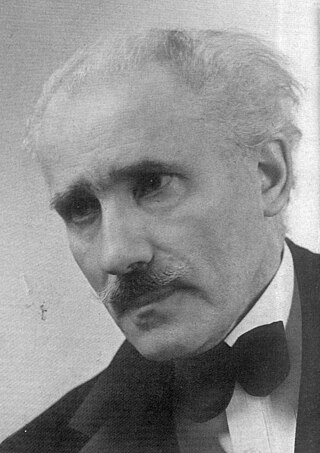
Arturo Toscanini was an Italian conductor. He was one of the most acclaimed and influential musicians of the late 19th and early 20th century, renowned for his intensity, his perfectionism, his ear for orchestral detail and sonority, and his eidetic memory. He was at various times the music director of La Scala in Milan and the New York Philharmonic. Later in his career, he was appointed the first music director of the NBC Symphony Orchestra (1937–1954), and this led to his becoming a household name, especially in the United States, through his radio and television broadcasts and many recordings of the operatic and symphonic repertoire.

Leopold Anthony Stokowski was a British conductor. One of the leading conductors of the early and mid-20th century, he is best known for his long association with the Philadelphia Orchestra. He was especially noted for his free-hand conducting style that spurned the traditional baton and for obtaining a characteristically sumptuous sound from the orchestras he directed.
The Pittsburgh Symphony Orchestra (PSO) is an American orchestra based in Pittsburgh, Pennsylvania. The orchestra's home is Heinz Hall, located in Pittsburgh's Cultural District.
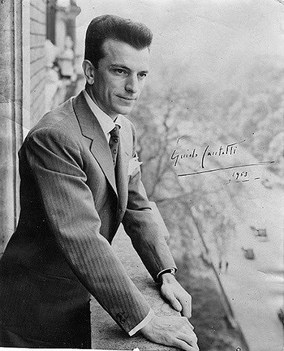
Guido Cantelli was an Italian orchestral conductor. Toscanini elected him his "spiritual heir" since the beginnings of his career. He was named Musical Director of La Scala, Milan in November 1956, but his promising career was cut short only one week later by his death at the age of 36 in the 1956 Paris DC-6 crash in France on route to the United States.

Lorin Varencove Maazel was an American conductor, violinist and composer. He began conducting at the age of eight and by 1953 had decided to pursue a career in music. He had established a reputation in the concert halls of Europe by 1960 but, by comparison, his career in the U.S. progressed far more slowly. He served as music director of The Cleveland Orchestra, Orchestre National de France, Pittsburgh Symphony Orchestra, Bavarian Radio Symphony Orchestra, and the New York Philharmonic, among other posts. Maazel was well-regarded in baton technique and possessed a photographic memory for scores. Described as mercurial and forbidding in rehearsal, he mellowed in old age.

Adagio for Strings is a work by Samuel Barber, arguably his best known, arranged for string orchestra from the second movement of his String Quartet, Op. 11.
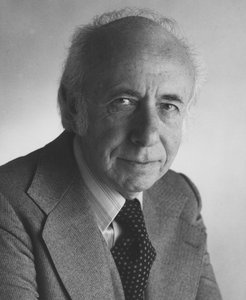
Morton Gould was an American composer, conductor, arranger, and pianist.

William Steinberg was a German-American conductor.
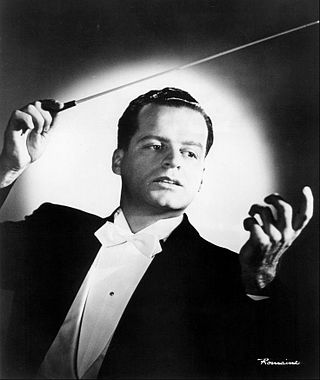
Carmen Dragon was an American conductor, composer, and arranger who in addition to live performances and recording, worked in radio, film, and television.
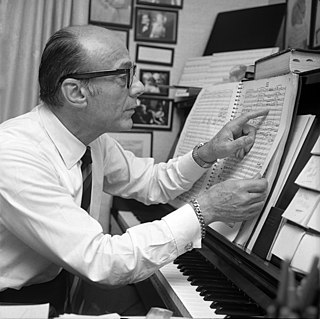
John Waldo Green was an American songwriter, composer, musical arranger, conductor and pianist. He was given the nickname "Beulah" by colleague Conrad Salinger. His most famous song was one of his earliest, "Body and Soul" from the revue Three's a Crowd. Green won four Academy Awards for his film scores and a fifth for producing a short musical film, and he was inducted into the Songwriters Hall of Fame in 1972. He was also honored with a star on the Hollywood Walk of Fame.

Ernö Rapée was a Hungarian-born American symphonic conductor in the first half of the 20th century whose prolific career spanned both classical and popular music. His most famous tenure was as the head conductor of the Radio City Symphony Orchestra, the resident orchestra of the Radio City Music Hall, whose music was also heard by millions over the air.
Josef Alexander Pasternack was a conductor and composer in the first half of the 20th century.
Jeff Tyzik is an American conductor, arranger, and trumpeter. He has recorded jazz albums as a soloist and arranged pop and jazz music for orchestras.
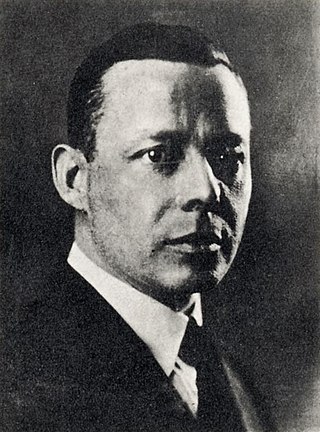
Joseph Charles Rosario Bourdon was a French Canadian cellist, violinist, conductor, arranger and composer. He was a child prodigy skilled with many musical instruments. Bourdon worked much of his life for the Victor Talking Machine Company where he exerted considerable influence.
The Cities Service Concerts were musical broadcasts which had a long three-decade run on radio from 1925 to 1956, encompassing a variety of vocalists and musicians sponsored by Cities Service.

Mac Morgan was an American bass-baritone who had an active performance career in concerts and operas from the early 1940s until the mid-1970s. The Boston Globe described him as a singer "known for his rich tone and enviable diction". After retiring from the stage, he embarked on a second successful career as a voice teacher.
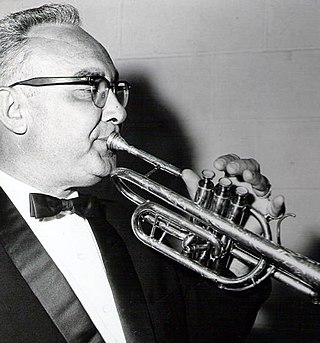
James Francis Burke was an American cornet soloist. He was the principal cornet soloist with the Goldman Band from 1943 to 1974. He was also the principal trumpet with The Baltimore Symphony Orchestra from 1943 to 1949. Mr. Burke, who had the use of only one arm, was considered the greatest virtuoso of his time on the instrument, according to Ainslee Cox, conductor of the Guggenheim Memorial Band.